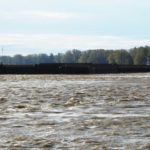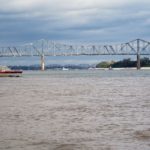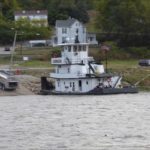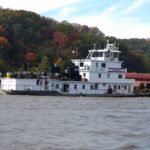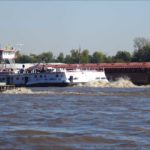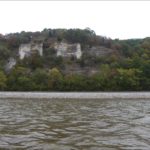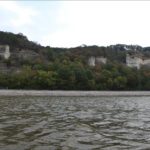October 22, 2017 Sunday
As we were leaving our snug, calm anchorage in the Castor River Diversion Channel a northbound tow with 35 (5 by 7) barges passed the mouth of the channel leaving a 3 to 4 foot 2-mile long wake that made us want to turn around and stay in the protected waters of the channel. As we pulled into the Mississippi River another northbound tow with 30 (5 by 6) barges passed us, between the two we felt like we were riding the old mechanical bull at Billy Bob’s.
With only 48.8 miles remaining of the Upper Mississippi River, we continued to stay vigilant as we watched for navigational markers, debris, and landmarks. Our first landmark was the Thebes Railroad Bridge which opened on May 25, 1905, and is still the only railroad bridge between St. Louis and Memphis. According to local folklore, the history of railroad bridge disasters in the 1800s caused people to be fearful of the new iron and steel bridges. In order to instill confidence in the strength of the bridge a long line of steam locomotives crossed the bridge at once. If the bridge could handle the weight of the massive locomotives, it could handle anything.
The river remained wild until we met calmer waters in the oxbows north of Cairo. At the end of the Upper Mississippi, we turned to our port and entered the mouth of the Ohio River. The Ohio River begins at the junction of the Monongahela and Allegheny Rivers at Pittsburgh, PA and continues for 981 miles, we will travel just eighty-nine miles of the Ohio River and then take the Cumberland River back to Lake Barkley.
We were running at about 10.5 knots at 1200 RPM (11 miles per gallon) on the Mississippi River when we turned into the Ohio River, we immediately fell to 5 knots. We increased RPM to 1600 and got another knot to 6 but fuel mileage fell to 2.7 MPG.
At one time Abe Lincoln also cruised the Mississippi and Ohio Rivers, however, his trips were much different from ours. In 1828 and again in 1831 he was a bow-hand on Allen Gentry’s two-man flatboat that was loaded with furs for the New Orleans market. It was through his firsthand experiences with the slave-markets in New Orleans that he developed his lifelong hatred of slavery.
Tonight we are anchored on the Kentucky side of the Ohio near La Center, KY in 18 to 20 feet. The rain is pouring and we are kicking-back enjoying what might be our last anchorage of the trip.




